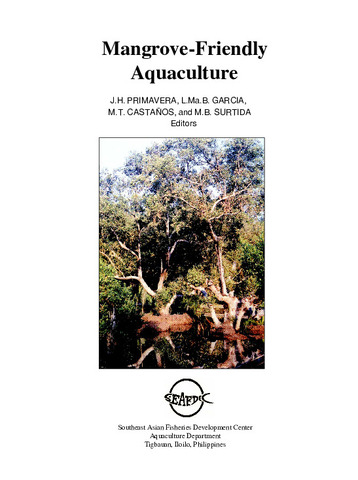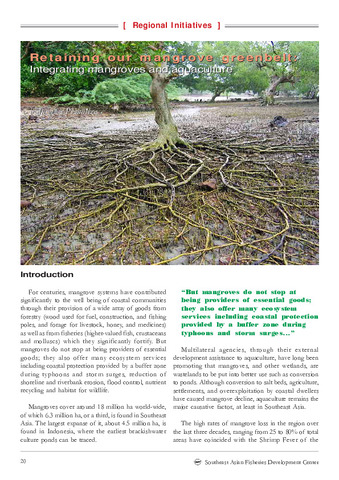Mangrove zooplankton of Matang mangrove estuaries: Preliminary assessment of spatio-temporal abundance in relation to environmental parameters
| dc.contributor.author | Chong, Ving Ching | |
| dc.contributor.author | Ooi, Ai Lin | |
| dc.contributor.author | Chew, Li Lee | |
| dc.contributor.author | Ogawa, Yasuki | |
| dc.contributor.editor | Ogawa, Yasuki | |
| dc.contributor.editor | Ogata, Hiroshi Y. | |
| dc.contributor.editor | Maeno, Yukio | |
| dc.contributor.editor | Shimoda, Toru | |
| dc.contributor.editor | Fujioka, Yoshimi | |
| dc.contributor.editor | Fukuda, Yutaka | |
| dc.date.accessioned | 2021-07-12T08:14:32Z | |
| dc.date.available | 2021-07-12T08:14:32Z | |
| dc.date.issued | 2003 | |
| dc.identifier.citation | Chong, V. C., Ooi, A. L., Chew, L. L., & Ogawa, Y. (2003). Mangrove zooplankton of Matang mangrove estuaries: Preliminary assessment of spatio-temporal abundance in relation to environmental parameters. In Y. Ogawa, H. Y. Ogata, Y. Maeno, T. Shimoda, Y. Fujioka, & Y. Fukuda (Eds.), Proceedings of the 2nd Workshop of the JIRCAS International Collaborative Research: Studies on Sustainable Production Systems of Aquatic Animals in Brackish Mangrove Areas , December 2-3, 2002, Penang, Malaysia (pp. 21-43). Japan International Research Center for Agricultural Sciences. | en |
| dc.identifier.issn | 1341-710X | |
| dc.identifier.uri | http://hdl.handle.net/10862/6093 | |
| dc.description.abstract | An on-going zooplankton study in the Matang mangrove swamp beginning April 2002 has shown that zooplankton wet biomasses determined over 5 months were relatively higher inside the mangrove swamp (1.17± 0.35 g m-3) than in adjacent offshore waters (0.87 ± 0.55 g m-3). Total zooplankton densities ranged from 1.2 x 104 - 5.82 x 104 individuals per m3 inside the swamp, whereas in offshore waters zooplankton densities ranged from 1.03 x 104 - 2.83 x 104 individuals per m3. Crustaceans, dominated by copepods and cirripede larvae, constituted more than 70%, followed by polychaetes and chaetognaths. Fish larvae made up less than 0.5% of the total densities. Preliminary PCA of 50 zooplankton taxa suggests that the swamp taxa but not (so much) the offshore taxa differed spatio-temporally, and that more fish larvae and young copepods were caught inside the swamp. The larval fish density (surface hauls) ranged from 12-669 individuals per 100 m-3 inside the swamp, whereas in offshore waters it ranged from 21-290 individuals per 100 m-3. The major families of fish larvae were Engraulididae (ca. 60%) and Gobiidae (ca. 30%). Engraulid larvae were ubiquitous in distribution occurring from swamp to 14 km offshore, while gobiid larvae were more restricted to the swamp. Other families identified included the Scatophagidae, Ambassidae, Blennidae, Sciaenidae, Cynoglossidae, Scorpaenidae, Carangidae and Syngnathidae. Preliminary CCA suggests that salinity, turbidity and zooplankton size and abundance may be important factors regulating the distribution and abundance of fish larvae. However, its interpretation is cautioned due to the limited data. A larger data set is needed to correlate larval fish abundance with the environmental factors. | en |
| dc.language.iso | en | en |
| dc.publisher | Japan International Center for Agricultural Sciences | en |
| dc.relation.ispartofseries | JIRCAS Working Report;No. 35 | |
| dc.subject | Serranidae | en |
| dc.subject | Lutjanidae | en |
| dc.title | Mangrove zooplankton of Matang mangrove estuaries: Preliminary assessment of spatio-temporal abundance in relation to environmental parameters | en |
| dc.type | Conference paper | en |
| dc.citation.spage | 21 | en |
| dc.citation.epage | 43 | en |
| dc.citation.conferenceTitle | Proceedings of the 2nd Workshop of the JIRCAS International Collaborative Research: "Studies on Sustainable Production Systems of Aquatic Animals in Brackish Mangrove Areas", December 2-3, 2002, Penang, Malaysia | en |
| dc.subject.asfa | mangroves | en |
| dc.subject.asfa | zooplankton | en |
| dc.subject.asfa | physicochemical properties | en |
| dc.subject.asfa | water temperature | en |
| dc.subject.asfa | plankton | en |
Files in this item
| Files | Size | Format | View |
|---|---|---|---|
|
There are no files associated with this item. |
|||
This item appears in the following Collection(s)
-
Sustainable Production Systems of Aquatic Animals in Brackish Mangrove Areas [13]
Proceedings of the 2nd Workshop of the JIRCAS International Collaborative Research




